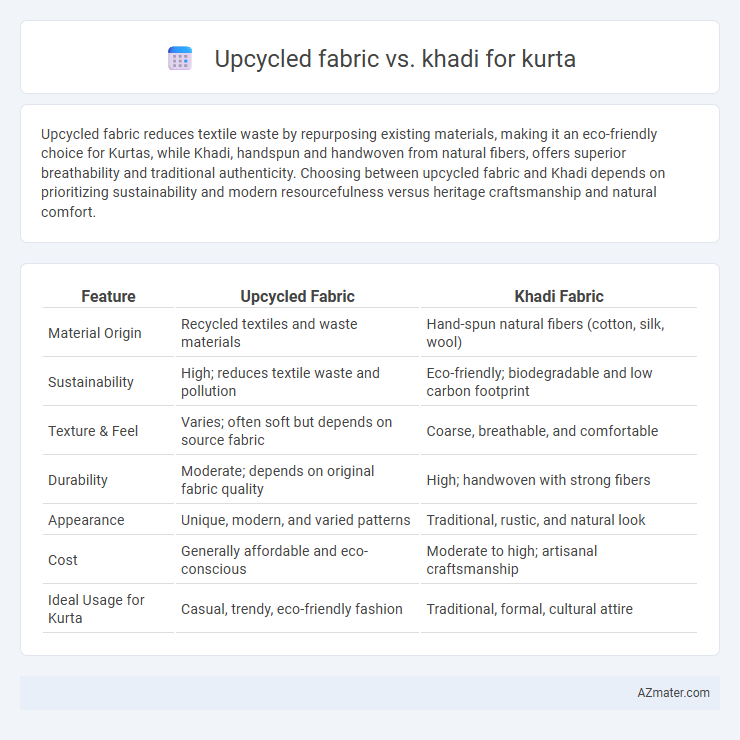Upcycled fabric reduces textile waste by repurposing existing materials, making it an eco-friendly choice for Kurtas, while Khadi, handspun and handwoven from natural fibers, offers superior breathability and traditional authenticity. Choosing between upcycled fabric and Khadi depends on prioritizing sustainability and modern resourcefulness versus heritage craftsmanship and natural comfort.
Table of Comparison
| Feature | Upcycled Fabric | Khadi Fabric |
|---|---|---|
| Material Origin | Recycled textiles and waste materials | Hand-spun natural fibers (cotton, silk, wool) |
| Sustainability | High; reduces textile waste and pollution | Eco-friendly; biodegradable and low carbon footprint |
| Texture & Feel | Varies; often soft but depends on source fabric | Coarse, breathable, and comfortable |
| Durability | Moderate; depends on original fabric quality | High; handwoven with strong fibers |
| Appearance | Unique, modern, and varied patterns | Traditional, rustic, and natural look |
| Cost | Generally affordable and eco-conscious | Moderate to high; artisanal craftsmanship |
| Ideal Usage for Kurta | Casual, trendy, eco-friendly fashion | Traditional, formal, cultural attire |
Introduction to Sustainable Fabrics for Kurtas
Upcycled fabric repurposes discarded textiles into unique, eco-friendly kurtas, reducing waste and conserving resources. Khadi, a hand-spun and handwoven cotton fabric, symbolizes sustainability through its organic production and support of rural artisans. Both fabrics offer environmentally conscious alternatives, making kurtas stylish while promoting ethical fashion choices.
What is Upcycled Fabric?
Upcycled fabric is created by repurposing discarded textiles or clothing, transforming them into new, high-quality materials for garments like kurtas. This sustainable approach reduces textile waste and lowers environmental impact compared to traditional fabric production. In contrast, Khadi is handspun and handwoven fabric with cultural significance, known for its natural texture and breathability in kurta designs.
Understanding Khadi: A Heritage Cloth
Khadi is a hand-spun and hand-woven natural fiber cloth rooted in India's heritage, symbolizing sustainability and cultural identity. Unlike upcycled fabric, which repurposes existing materials to reduce waste, Khadi is crafted from raw cotton, silk, or wool through traditional methods that emphasize eco-friendliness and artisanal craftsmanship. Wearing a Khadi kurta not only supports indigenous weavers but also reflects a commitment to slow fashion and organic textile production.
Environmental Impact: Upcycled Fabric vs Khadi
Upcycled fabric reduces textile waste by repurposing discarded materials, significantly lowering landfill contribution and conserving resources compared to virgin fabric production. Khadi, hand-spun and hand-woven using natural fibers, promotes sustainable agriculture and minimal energy consumption, making it biodegradable and eco-friendly. Both materials support eco-conscious fashion, but upcycled fabric prioritizes waste reduction while Khadi emphasizes traditional, low-impact manufacturing processes.
Production Processes Compared
Upcycled fabric is produced by repurposing textile waste through processes like cutting, stitching, and dyeing, minimizing environmental impact and resource consumption. Khadi undergoes a traditional, labor-intensive hand-spinning and hand-weaving process using natural fibers such as cotton, creating a breathable, textured fabric with cultural significance. While upcycled fabric emphasizes sustainability through recycling, Khadi highlights craftsmanship and heritage with its artisanal production methods.
Aesthetics and Design Versatility
Upcycled fabric offers unique textures and patterns, lending each kurta an exclusive, eco-friendly aesthetic that highlights sustainability and creativity. Khadi provides a rustic, handwoven charm with natural fibers that enhance breathability and comfort, reflecting traditional craftsmanship. Design versatility in upcycled fabric allows for bold, contemporary styles, while khadi excels in timeless, minimalist silhouettes perfect for both casual and formal wear.
Comfort and Wearability Factors
Upcycled fabric offers unique patterns and eco-friendly appeal but may vary in texture and breathability, affecting comfort for Kurta wearers. Khadi, handspun and handwoven from natural cotton or silk, provides superior ventilation, softness, and moisture absorption, ensuring all-day wearability in warm climates. Both materials support sustainability, but Khadi's traditional craftsmanship delivers consistent comfort and durability ideal for everyday Kurta use.
Cost and Accessibility
Upcycled fabric offers a cost-effective and eco-friendly option for kurtas, often sourced from reclaimed textiles at lower prices than traditional fabrics. Khadi, known for its hand-spun and hand-woven qualities, tends to be pricier due to labor-intensive production and limited availability. Accessibility to upcycled fabric is higher in urban markets and online platforms, whereas Khadi is primarily available through specialty stores and government-supported outlets, impacting overall affordability and convenience for consumers.
Cultural and Social Significance
Upcycled fabric embodies sustainability and contemporary eco-consciousness, transforming discarded textiles into unique Kurta designs that reduce environmental impact and promote ethical fashion. Khadi, deeply rooted in Indian heritage, symbolizes self-reliance, freedom struggle, and rural empowerment, reflecting a rich cultural legacy that supports local artisans and traditional hand-spinning techniques. Choosing Khadi reinforces national identity and community craftsmanship, while upcycled fabric highlights modern innovation in sustainable fashion practices.
Choosing the Right Fabric for Your Kurta
Upcycled fabric offers a sustainable and eco-friendly choice for kurtas, reducing textile waste while providing unique patterns and textures that add individuality to each piece. Khadi, a hand-spun and hand-woven fabric, is celebrated for its breathability, durability, and cultural heritage, making it ideal for traditional kurtas that require comfort and elegance. Selecting between upcycled fabric and khadi depends on your preference for environmental impact, fabric texture, and the desired aesthetic of your kurta.

Infographic: Upcycled fabric vs Khadi for Kurta
 azmater.com
azmater.com